Muscular yet elegant, shaggy Irish wolfhounds are one of the largest breeds in the world. Their calm, gentle spirit makes them ideal family companions—for those who have the space. Learn more about living with Irish wolfhounds.
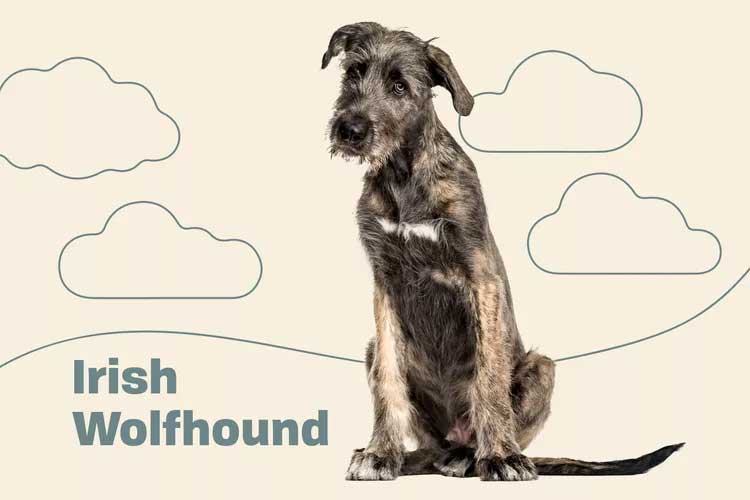
Irish Wolfhound Overview
| OFFICIAL NAME | Irish Wolfhound |
| COMMON NAME | Irish Wolfhound |
| PET HEIGHT | 30 to 35 inches |
| PET WEIGHT | 105 to 180 pounds |
| LIFESPAN | 6 to 10 years |
| GOOD WITH | cats, children, dogs, families, seniors |
| TEMPERAMENT | friendly, gentle, playful |
| INTELLIGENCE | high |
| SHEDDING AMOUNT | infrequent |
| EXERCISE NEEDS | medium |
| ENERGY LEVEL | calm |
| VOCAL LEVEL | quiet |
| DROOL AMOUNT | low |
| BREED GROUP | hound |
| BREED SIZE | extra large (101 lbs. or more) |
| COAT LENGTH | long, medium, wiry |
| COLORS | black, blue, cream, fawn, gray, red, white |
| PATTERNS | brindle |
| OTHER TRAITS | cold weather tolerant, easy to groom, easy to train, high prey drive, prone to health issues, strong loyalty tendencies |
Recognized as one of the largest breeds of dogs in the world, Irish wolfhounds are tranquil, easy beings who make very good family companions. Once bred to chase down large elk (and sometimes wolves!) today's Irish wolfhound is rarely seen on hunts. Rather, the Irish wolfhounds of today are more than content hanging around home with their humans.
This breed has a short lifespan—on average 7 years—and is prone to various health issues. Though not considered hypoallergenic, they do produce less dander than some other large dogs and may be suitable for someone with less severe dog allergies. It's important to consider every aspect of your life before committing to an Irish wolfhound.
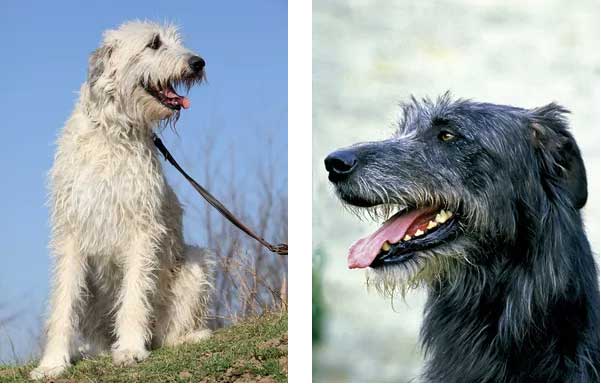
Appearance
The ancient Irish wolfhound has an air of dignity and a commanding presence. Though they can be intimidating in size, the gentle breed has a kind face with a sweet expression. Bred to hunt large game in the Irish countryside, the Irish wolfhound is a muscular yet elegant extra-large or giant breed. A healthy Irish wolfhound weighs at minimum 105 pounds (sometimes up to 180 pounds!) and stands at least 2 feet, 6 inches tall. That's a lot of dog!To protect against the sometimes-harsh Irish climate, the Irish wolfhound has a double coat: A soft undercoat that insulates him in all weather, and a longer, harsh and wiry top coat that's more prominent above the eyes and under the jaw (like eyebrows and a beard). The breed comes in many colors and patterns, but those recognized by the American Kennel Club include black, blue, brindle, gray, red, silver, wheaten, and white. Their coats shed moderately throughout the year, but, unlike most double-coated canines, Irish wolfhounds do not have heavier shedding seasons.
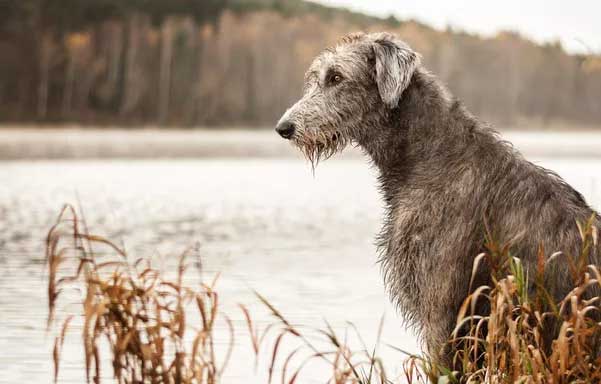
Temperament
Despite their large presence and hunting history (see below), Irish wolfhounds are one of the most serene, calm, and kind breeds in the world. They're intelligent and curious, at their happiest when walking outdoors beside their owners. Irish wolfhounds can be rambunctious in puppyhood—an 18-month period in which she may grow to 100 pounds!—but most adults are content with a daily walk combined with the opportunity to freely run, followed by quality time with her owner at home.Irish wolfhounds are gentle, affectionate, and amiable dogs known to be patient with children, which make them great for families who have the space—and income—to support a dog of this size.
As with any breed, it's important to properly socialize your Irish wolfhound from a young age. "If going to a breeder, it's important to pick your puppy carefully," says Brian Kilcommons, founder of The Great Pets Resort, a training facility in Connecticut. "With a breed of this size, you need to ensure you're getting a solid genetic foundation and that you take the time to socialize young."
A properly socialized Irish wolfhound can do well with cats and other pets, but may prefer to be the only dog. Irish wolfhounds are very large animals and, despite best intentions, may accidentally knock over or scare smaller children. They're best in a home with older children, and children should never sit on an Irish wolfhound's back. It's important to teach children how to properly interact with dogs and always supervise them when playing with any animal.
Living Needs
Because of their immense size, Irish wolfhounds require specific living arrangements. An ideal home for an Irish wolfhound has a large, fenced-in yard and ample indoor space for this gentle giant to stretch out. A layout with no stairs would certainly make things easier should you ever need to transport a sick or injured Irish wolfhound by carrying, and a stair-free house will also be easier on the dog's joints.Loyal and sensitive, Irish wolfhounds thrive in the company of their humans and, like any breed, they shouldn't be left alone for long periods of time. They should be an active part of their owner's life. This extra-large breed doesn't require extensive exercise, but your dog will love getting outdoors to stretch her long legs (and show off her athletic gallop).
Though generally calm, Irish wolfhounds won't be a good fit for many and are best with experienced dog owners. "They're going to have a pretty strong prey drive," Kilcommons says. "They're sighthounds, and as far as working with their instincts, it makes it a lot easier if you understand that anytime something moves, they're going to be interested."
If you're fortunate enough to have the space, lifestyle, and knowledge to support an Irish wolfhound, you'll be rewarded with one of the most beautiful, loving, and devout companions man has ever known. It's important to consider your lifestyle before committing to any dog. Talk to an Irish wolfhound breeder or rescue group to see if an Irish wolfhound is a good fit for you.

Care
Irish wolfhounds have thick, double coats consisting of a soft insulating undercoat and a medium-length harsh and wiry top coat. This breed sheds moderately year-round, but unlike most double-coated dogs, she never blows her coat. Brushing your Irish wolfhound once a week will keep her fur free of debris, mats, and loose dead hair. This breed's wire-textured hair tends to stay pretty clean, so they don't necessarily need full baths often—but you will need a large tub they can easily access when bath day does arise. The Irish Wolfhound Club of America has thorough guides for grooming your dog.Regular brushing is a good time to check for things such as nail length and ear and dental health. Her nails should be trimmed if you can hear them tapping against the floor. Ear canals should be pale pink with very little—and fairly odorless—wax. Be sure to look for any signs of movement (mites!) and foreign objects in the canal, especially if you and your dog spend a lot of time outdoors or have recently been in tall grasses. Much of this routine care can happen at home, but always reach out to your veterinarian if you have concerns, or employ a professional groomer to help.
Irish wolfhounds are intelligent and quick learners, and positive-reinforcement training is vital to their mental wellbeing. Though their exercise needs are relatively low compared to some other breeders, and you certainly won't find them fighting wolves these days, they'll benefit greatly from activities that are a nod to their roots.
"People tend to pick dogs based on their looks," Kilcommons says. "Part of being a good owner is understanding what the breed was created for, what they're hardwired for, and playing to those basic instincts. Irish wolfhounds are sighthounds, which means they [were historically used to hunt]. They're not hunting wolves these days, but we can work around that. Lure coursing or straight racing are great activities to get involved in, where you're exercising them while at the same time fulfilling a genetic requirement or need that they were bred for."
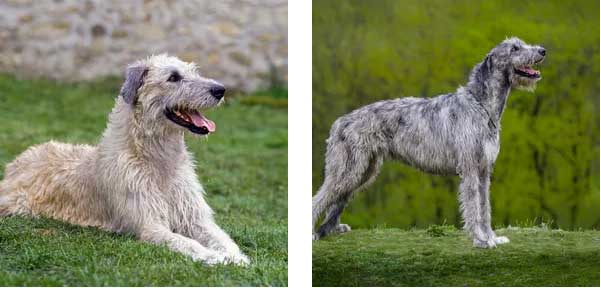
Health
The Irish wolfhound is one of several giant or extra-large dog breeds, and with their size come various health issues and a shorter lifespan—just 7 years on average. The Irish Wolfhound Club of America, the official breed club, strongly recommends breeders test for hip dysplasia and elbow dysplasia as well as complete a thorough eye evaluation and heart exam. The club recommends additional screening of breeding stock for pneumonia, heart disease, various cancers, and liver shunt.The breed is also prone to bloat, a serious condition that tends to affect larger breeds and can lead to death. It's important to know the signs of bloat and to seek emergency medical attention if you believe your dog is suffering.
Not all Irish wolfhounds will experience serious health issues, but it's important to be aware of these common concerns when considering the breed. It's also important to purchase all dogs from reputable breeders who will introduce you to the dog's parents and siblings. If adopting a dog, ask the rescue for all available health history.
History
A breed with lineage dating to antiquity, there's plenty of myth and legend surrounding the Irish wolfhound's history. The first recorded mention comes from ancient Rome in 391 AD, when Roman Consul Quintus Aurelius was gifted seven Irish wolfhounds. Irish wolfhounds were longtime favorites amongst nobility—including Henry VIII and Elizabeth I of England and Henry IV of France—and were often given as gifts between friendly kingdoms.In Ireland, the large sighthounds gained fame and popularity among chieftains and were often employed to hunt large game. The courageous creatures were successful hunters—so much so that they almost became extinct in the 1700s after they ridded the Irish land of big-game animals. No longer required for hunting, the Irish wolfhound was rarely bred and was kept most often as a multipurpose farm dog.
Then, in 1862, a British army captain named George Augustus Graham fell in love with the gentle giants and sought to protect, standardize, and reinvigorate the breed. To do this, Graham bred the Irish wolfhound with the Glengarry deerhound, borzoi, Tibetan mastiff, and Great Dane. Today's Irish wolfhounds are a result of this effort.
Though beloved by many, Irish wolfhounds are not a common breed in most households. Because of their size and weight, they require very specific living conditions and considerations.
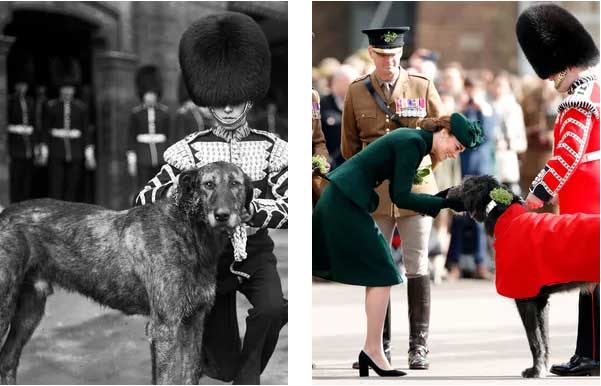
Fun Facts
In 1902, an Irish wolfhound named Brian Boru was presented to the Irish Guards as a mascot by the Irish Wolfhound Club in hopes that the publicity would increase the breed's popularity. The tradition continued, and the Irish Guards are the only Guards regiment allowed to have their mascot lead them on parade. The regiment's 16th mascot, Domhnall, was photographed several times with Prince William and Duchess Catherine and family; he retired back to Ireland in 2019.Irish wolfhounds are one of the largest breeds in the world. Standing 30 inches at minimum, they rank as the AKC's tallest breed.
The breed has many famous fans, including film director John Huston, former President John F. Kennedy, Trudie Styler and husband Sting, John Entwistle of The Who, and supermodel Claudia Schiffer.
Irish wolfhounds are an ancient breed mentioned in Irish laws and Irish literature dating back to the 5th century, with the name cú (translated as hound, Irish hound, war dog, and wolf dog).